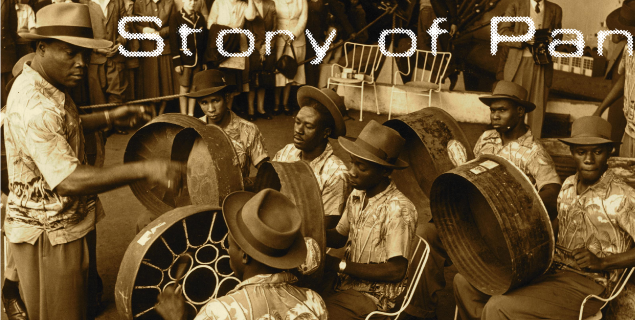· STEEL PAN. FRUIT OF THE NEED AND THE INGENIOUS OF A PEOPLE

According to the story that Wistom "Spree" Simon had a barrel, which he lent and came back with bruises, in an attempt to return the original shape to the surface of the barrel, it was convex and he discovered that the most marked dents produced "notes", which then tried to fine tune.
Here it all begins, In Laventille, a neighborhood located in the hills near Port of Spain, capital of the islands in Trinidad. Immediately the barrels multiplied with between two and four notes and were incorporated into the steel bands.
It appeared by then (in the late 40's) Ellie Mannette, and thought that we had to sink the surface, making it concave and defining on this up to 8 notes of a diatonic scale, were the first "steel drums". From that moment the amount of notes in the same barrel increased and began to consider how to distribute them.
The fashion spread and the musicians were busy building metal pots with everything they had. The rise of the oil exploitations on the island left landfills full of barrels, and in 1946 a musician took a barrel of 55 galleons to which he "dented" the surface to be able to play musical notes on it. He managed to incorporate a total of 14 notes that soon afterwards incorporated drumsticks (small clubs to hit) and the instrument began to take shape.
The STEELPAN continued to evolve until they were built in various sizes and different shades. A specific and quite complex construction technique was developed. A new instrument was born, fruit of necessity and ingenuity, which would eventually become a symbol of the traditional Caribbean culture.
With these rudimentary steel drums they could already play simple songs and, at the same time, the need to extend the range grew, to reach higher or lower tessitura and to be able to reproduce the popular music of the island: the Calypso. Currently it has overcome borders and is used in different countries and musical styles.
Throughout the history of steelpan several innovators have contributed to the development of the instrument as for example
Wintom "spree" Simon
He is credited with creating the first melodic "steel pan" composed of eight notes capable of playing a complete melody
Ellie Mannette
Anthony Williams
Bertie Marshall
Accredited with the invention of "double tenor" bread. He also recognized the negative effects of the sun on the steel pan and was the first to place the awnings on the instruments when they were played outdoors.
Despite the achievements and the hard work of the innovators, the modern "steel pans" still have some limitations.
For example
• Most have a limited range compared to other instruments (approximately 2 1/2 octaves)
• Higher notes from front-line sources do not sound as good as lower notes
• The serious instruments are large, difficult to transport and take up a lot of space
• Some musical effects such as staccato (a separate style of playing) are difficult to achieve in steelpan.
Steel Pan is a work in progress. Manufacturers of pans around the world are constantly researching ways to improve and refine the instrument.
In the decade of 1930 when the instrument appeared it was not seen very seriously and on the contrary the creators and the instrument were despised by the upper class of the trinity society since they were created and executed by the ghettos and used by the hooligans in their violent actions.
Time and exposure eventually eroded this stigma and steel pan is now the national instrument of the Republic of Trinidad and Tobago and a source of great pride for its citizens. Steel Pan and its innovators are now held in high esteem by people of all levels of society in Trinidad and Tobago

The musical possibilities of the nascent formations posed the challenge of being able to perform any musical style, even classical music.
It was possible to take advantage of the barrel to the maximum although a single barrel was limited to get low tessitura since the size of the notes is greater the more serious is the note. Thus we have "TENOR" simple barrels of 29 notes for the highest tessitura, more than two octaves, and multiple barrels for the "BASS" section with only three notes per barrel. There are double steel drums (two barrels per instrument) of three types that go down from the "DOUBLE TENOR" to the "DOUBLE GUITAR", triple steeldrums that make the function CHELLO or LOW and sextuples or more barrels, to cover the "BASSES"record
Based on Ellie Mannette's original design, the Invader, or Low Lead, is well known for its versatility and is used by the world's top professional performers such as Andy Narell, Len "Boogsie" Sharpe, Ray Holman, Robert Greenidge and Tom Miller . . The sonority of the Invader Lead is unique in its purity of tone and works as an excellent solo instrument. The range of the instrument C4-F6.










SALMON E. CUPID. the inventor and patent holder of the first and only electronic synthesized steel pan (E-PAN), born and raised in the republic of trinidad and tobago comments that his invention was the product of a need to give the public a better quality of sounds of steel pan when it is performed outdoors, and in recording sessions, this idea was conceived in its youth more than 25 years ago, which materialized with the delivery of a very versatile product for the steelpanistas who enjoy their sonorous timbres, that could vary for the purpose of metal instruments or others and also has a high range of sounds (13) octaves. Currently the steelpan community is proud and enthusiastic about the achievements obtained with this instrument that has crossed borders being recognized by international communities the success achieved that enhances the culture of Trinidad and Tobago, EL STEELPAN
fuentes
https://www.elblogalternativo.com/.../el-steel-drum-un-instrumento-creado-en-tiempos...
https://musicadebarril.wordpress.com/2013/12/19/origenes-de-los-steel-drums/
https://media.gettyimages.com/photos/children-playing-drums-saint-lucia-caribbean-picture-id85652777
www.panonthenet.com/news/2010/mar/epancupid-3-21-10.html